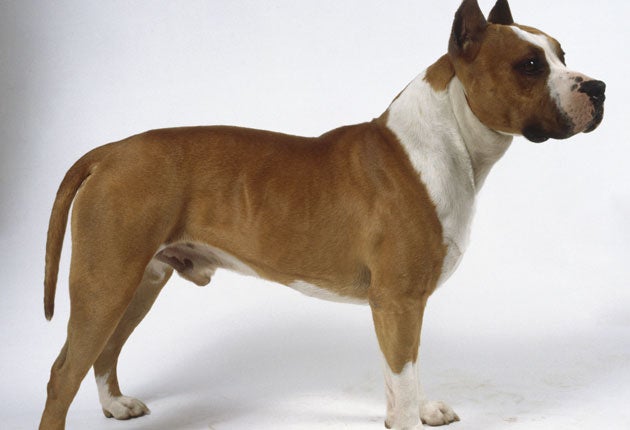A lethal weapon on a lead?
The pit bull is the most notorious of the 'dangerous dogs'. But is there more to these status symbols than meets the eye? Kate Burt anatomises the arguments

What Is a pit bull?
Yesterday, a Government consultation proposed reviewing the 1991 Dangerous Dogs Act, which made it illegal to own a "pit bull type" dog. With both more attacks by dogs (up by 79 per cent in the capital, according to the Greater London Authority) and dog fights (which increased 12-fold between 2004-2008, says the RSPCA), and the rising trend for intimidating "status" dogs (over 1000 seized by Police in London in the last year, up from just 43 in 2003), the law is simply not working. But what is a "pit bull type dog"? It's complicated. "A derivative of the American Pit Bull Terrier [the type photographed here], originally bred in America for dog fighting," explains Caroline Kisko of the Kennel Club. "However, in the UK it is defined in law as a type of dog sharing similar characteristics. This is at the crux of why the Act is so flawed because it is so difficult to define what a pit type dog looks like." The Metropolitan Police's Status Dogs Unit compares a suspect dog's physique to established characteristics from the American Dog Breeders Association standard to define "pit bull type", taking into account the dimensions of its head, its height and its gait. But, says Kisko, certain dogs that simply look similar can be "demonised".
Faster, better, stronger
The original version of the pit bull type – and common ancestor for the Staffordshire bull terrier, bull terrier, American pit bull terrier and American Staffordshire terrier – was known as the "bull and terrier" dog. It first emerged in pre-19th century England, when bull- and bear-baiting was a popular sport. Breeding produced a more active and long-legged predecessor to today's versions, which fought well against these large creatures in special pits (hence its later name). But when such bloodsports were outlawed, dog fighting gained popularity instead, and breeders honed a smaller, more agile version better suited to the purpose. It looked a lot like today's Staffordshire bull terrier.
Bred to bite?
Pit bull-type breeds have long had a reputation for having excessively strong jaws capable of "locking" when they bite. This is nothing more than urban legend, suggests the American Kennel Club, citing scientific research proving that "there is nothing in the skeletal structure of the pit bull terrier jaw any different from that of any other dog in respect to locking". The problem, it is widely agreed, is with the owners – something campaigners hope the revised legislation will take into account. In fact, reports that owners train dogs to clamp onto tree branches are more likely to be behind the locked-jaw story (trees in East Barnet last year suffered over £1,000 worth of damage from this training technique). Sharon Bolt outlines other aggression-inducing training methods among many status dog owners: "Reward-based training can be reversed," she explains. "A group of lads might hype a dog up by, say, putting it in a confined space like a lift so it gets scared, and then give it treats when – inevitably – it lashes out." But this tactic would be effective with any dog, she says.
Meet Staffie, the pit bull's long-legged relative
A close relative of the pit bull, the Staffordshire bull terrier is probably the UK's most highly prized legal status dog (and according to a 2007 Police report, made up 56 per cent of all stolen dogs in the UK), though is often cross-bred to incorporate more pit bull characteristics. Scan puppy adverts and you'll often see descriptions such as, "Irish Staffies", "American Staffies" or "long-legged Staffies" – all euphemisms for pit bull terrier. So the Staffordshire gets a bad name. The "Staffie" combination of strength and a tough image, its British heritage and a loyal and loving nature at home (it's regularly recommended as the ideal family pet by breed guides) has helped to make it a trophy dog for those who want to look tough. As Sharon Bolt, a expert in canines at Good-dog.co.uk says, "Chihuahuas can be vicious, I've even worked with a Labrador who hospitalised a family member – but they don't have the hard image that the Staff has, so [people looking for a status dog] don't choose them."
To neuter or not?
Male dogs tend to be more aggressive than females – particularly with each other (and so are popular in dog fights). Which is why, along with microchipping, enforced neutering is on the list of proposals for the new legislation. There has been sceptism, however, about the idea of enforced insurance – "yeah, because dangerous drivers are always the ones with insurance, aren't they?" ranted one critic on Twitter. There has also been a suggestion that insurance companies are courting the Government for an income boost.
is the next step 'dogbos'?
Status dogs are becoming a political lever – with the Conservatives and Liberal Democrats both recently highlighting the rise in attacks in the last 10 years of Labour rule. With each party trying to outdo the other in ingratiating itself to Middle England, and tackling "yob culture" and bandying around suggestions such as issuing "dogbos" for offending canines, the outcome of the revised bill is likely to be back in the news very soon.
Join our commenting forum
Join thought-provoking conversations, follow other Independent readers and see their replies
Comments